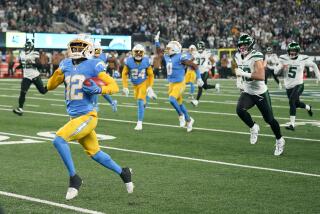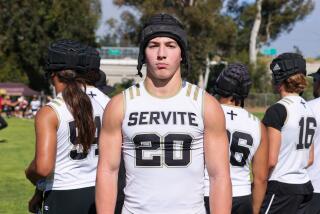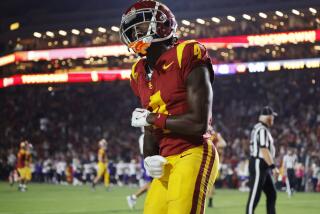For rookies, it’s so much better to receive in the NFL
All over the NFL map, rookie receivers are reeling in passes thrown, well, all over the map.
From A.J. Green in Cincinnati to Julio Jones in Atlanta, from Torrey Smith in Baltimore to Denarius Moore in Oakland, from Jon Baldwin in Kansas City to unrelated — but equally sure-handed — Doug Baldwin in Seattle, first year pass-catchers are disproving that theory that young receivers need at least a season to get comfortable in the pros.
Oh, there have been plenty of exceptions in the past, guys like Randy Moss, Anquan Boldin, Bob Hayes and Cris Collinsworth. But many more wideouts struggled through their rookie seasons, as Jerry Rice did when he dropped more than his share of passes on his way to a 49-catch, three-touchdown season.
In the words of Chiefs Coach Todd Haley, who coached receivers for years: “For rookies, it’s not always a slam dunk to come in and have an easy go of it.”
In the past couple of weeks, the Bengals’ Green and the Falcons’ Jones, both big and physical receivers, have made some “All-DVR” catches, and the Ravens’ Smith made the winning touchdown catch against Pittsburgh (a grab that atoned for would-be touchdown that eluded his grasp moments earlier.)
Oakland’s Moore and Kansas City’s Baldwin have disappeared for weeks at a time, yet have shown flashes of excellence. Moore had five catches for 146 yards in a Week 2 loss at Buffalo, and had two more touchdown passes Thursday against the Chargers. Baldwin, who has been dealing with a thumb injury reportedly as a result of a camp fight with teammate Thomas Jones, had five catches for 82 yards in a victory over San Diego.
Seattle’s Baldwin, an undrafted free agent from Stanford, is a 5-foot-10 slot receiver who leads the Seahawks in catches with 28. He has been an excellent safety valve for Seahawks quarterbacks Tarvaris Jackson and Charlie Whitehurst, who have been hurried and harassed all season.
Not only was Doug Baldwin not selected in the seven rounds of the draft, but also he wasn’t invited to the scouting combine. He showed up at the Seahawks’ camp with three days of clothes because he didn’t anticipate lasting any longer.
So how are these rookies — particularly the 6-4, 207-pound Green (40 catches) and the 6-3, 220-pound Jones (28 catches) — making such a splash right away?
Part of it is defensive players are handcuffed by rules that promote big plays and a lot of scoring. Receivers don’t have to worry about defenders making contact with them five yards past the line of scrimmage. They also know officials are ready to throw the flag if anyone hits a receiver high before he has completed a catch. That has taken away some of the trepidation of going over the middle.
Green and Jones are both bigger than most defensive backs who cover them, they’re fast enough to get behind a defense, and they’ll catch any jump-ball pass thrown in their vicinity.
“These guys are bigger, faster and stronger than we were,” Raiders great Tim Brown said. “I’m not saying they’re better football players; I’m not going to give them that.”
As Brown sees it, their size is both an asset and a liability.
“The position of receiver isn’t made for a guy who’s 6-4 or 6-5,” he said. “The reason is, you have to be able to run routes. And when you wear a size 14 or 15 shoe, it’s hard to put those big ol’ feet in the ground and get out of that break.
“So you’re not going to be a route runner. You can be a pass catcher and do some things, but you’re not going to be a technician.”
That said, because college offenses are so focused on passing, a lot of receivers are coming into the league having shouldered more responsibilities and having perfected their game in a more nuanced fashion.
“In 1978 when I came into the league, we had a route tree — basically routes one through nine,” Hall of Fame receiver James Lofton said. “My last year in Oakland [as wideouts coach in 2008], I was drawing up the routes for the wide receivers, and I got up to 58 of them.”
That only increases the pressure on defenses, which — partly because of the rules changes that tend to favor offensive players — don’t have the same intimidators and shut-down corners they did in years past.
“Back then, guys only had to take away three or four of those routes,” Lofton said. “Now, if a defender takes away three or four routes, he’s still got 50 more to contend with.”
twitter.com/LATimesfarmer
More to Read
Go beyond the scoreboard
Get the latest on L.A.'s teams in the daily Sports Report newsletter.
You may occasionally receive promotional content from the Los Angeles Times.











